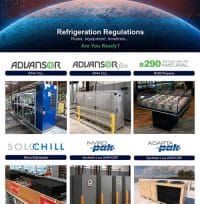
The Department of Energy (DOE) has put rules and regulations in place impacting the commercial refrigeration industry. Equipment consisting of low- and medium-temperature refrigerated display cases, walk-in freezers and anything collectively referred to as commercial refrigeration equipment, manufactured in the United States, is subject to adhering to energy conservation standards where these standards on the equipment are determined to result in significant conservation of energy and achieve maximum improvement in energy efficiency. These regulations will impact the OEMs, contractors, suppliers and end-users across the industry, as they will be required to adhere to these new regulations.
So, what does all this mean?
Since 2017, OEMs of refrigerated reach-in, stand-alone equipment (like Hillphoenix) have been required to adhere to the mandated regulations the DOE has established. These are specifically targeting items like condensing units, evaporators, doors, panels and lighting much of which make up all, if not the lion share of, this equipment. Beginning January 2020, all medium-temperature condensing units and self-contained units must be compliant and meet the Annual Walk-In Energy Factor (AWEF) which is a measure of total heat (BTUs) from a walk-in cooler to total energy in watt hours during a one-year period.
Specifically, what equipment falls under these requirements?
The equipment that falls under these regulations include:
- Walk-in Coolers/Freezers up to 3000ft
- Condensing Units and coolers used in walk-in coolers and freezers up to 3000ft
- Unit coolers used in supermarket refrigeration systems with dedicated walk-in coolers and freezers under 3000ft
- Doors and panels used to construct walk-in coolers and freezers
Beginning July 2020, newly manufactured low-temperature condensing units and self-contained units must be compliant and meet regulations.
It’s important to be aware of the changing and updated regulations that are evolving over time, an as time goes on, we will continue to update and populate this page information as it becomes readily available.
Additional Resources
CARB – The Refrigerant Management Program (RMP) requires facilities with refrigeration systems containing more than 50 pounds of high-GWP refrigerant to conduct and report periodic leak inspections, promptly repair leaks; and keep service records on site. The regulation also requires service practices intended to minimize refrigerant emissions. Read More>
- CARB Service Technicians
- CARB Distributors/Wholesalers and Reclaimers
- CARB Rules for Businesses with Refrigeration Systems
- SNAP Substitutes in Refrigeration and Air Conditioning
- SNAP Regulations including Rules 19-23
- Questions and Answers About SNAP Alternatives
- EPA Ozone-Depleting Substances – This page provides information on compounds recognized as ozone-depleting substances (ODS) under the Montreal Protocol.
- EPA Stationary Refrigeration Leak Repair Requirements including Section 608 of the Clean Air Act.
- DOE Compliance Certification Database Walk-In Coolers and Freezers – Doors
- DOE Energy Conservation Standards for Walk-in Cooler and Freezer Refrigeration Systems; Final Rule
